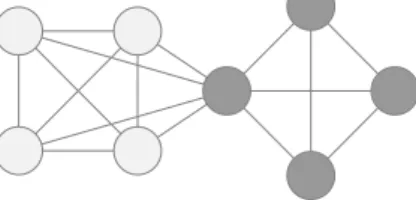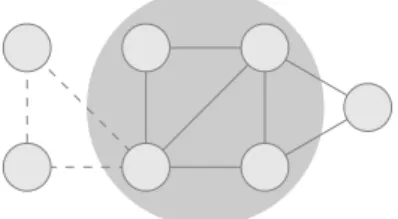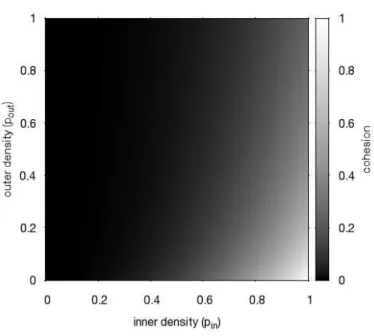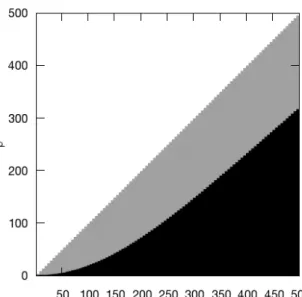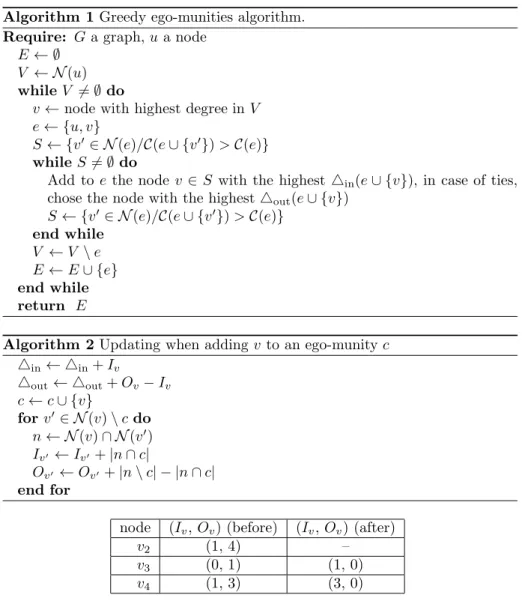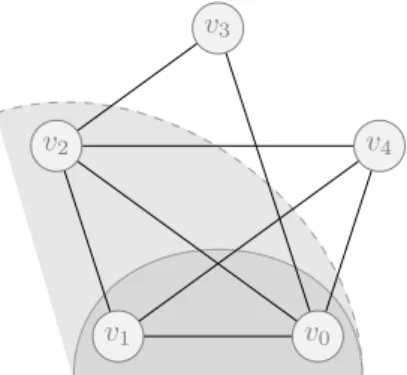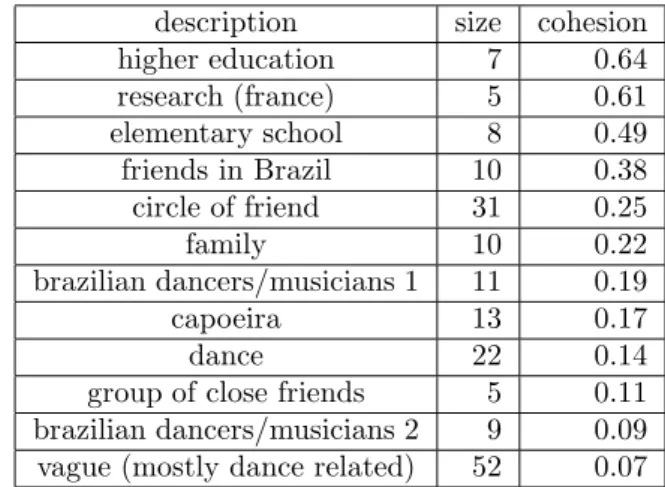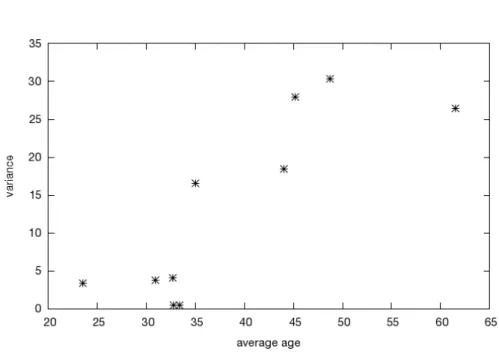Ego-munities, Exploring Socially Cohesive Person-based
Communities
Adrien Friggeri, Guillaume Chelius, Eric Fleury
To cite this version:
Adrien Friggeri, Guillaume Chelius, Eric Fleury. Ego-munities, Exploring Socially Cohesive
Person-based Communities. [Research Report] RR-7535, 2011.
<
inria-00565336v1
>
HAL Id: inria-00565336
https://hal.inria.fr/inria-00565336v1
Submitted on 13 Feb 2011 (v1), last revised 19 Jan 2011 (v2)
HAL
is a multi-disciplinary open access
archive for the deposit and dissemination of
sci-entific research documents, whether they are
pub-lished or not.
The documents may come from
teaching and research institutions in France or
abroad, or from public or private research centers.
L’archive ouverte pluridisciplinaire
HAL, est
destin´
ee au d´
epˆ
ot et `
a la diffusion de documents
scientifiques de niveau recherche, publi´
es ou non,
´
emanant des ´
etablissements d’enseignement et de
recherche fran¸cais ou ´
etrangers, des laboratoires
publics ou priv´
es.
a p p o r t
d e r e c h e r c h e
0 2 4 9 -6 3 9 9 IS R N IN R IA /R R --7 5 3 5 --F R + E N GEgo-munities
Exploring Socially Cohesive Person-based
Communities
Adrien Friggeri — Guillaume Chelius — Eric Fleury
N° 7535
Centre de recherche INRIA Grenoble – Rhône-Alpes
Exploring Socially Cohesive Person-based
Communities
Adrien Friggeri , Guillaume Chelius , Eric Fleury
Th`eme : R´eseaux et t´el´ecommunications ´
Equipe-Projet DNET
Rapport de recherche n°7535 — F´evrier 2011 — 18 pages
Abstract:
In the last few years, there has been a great interest in detecting overlap-ping communities in complex networks, which is understood as dense groups of nodes featuring a low outbound density. To date, most methods used to com-pute such communities stem from the field of disjoint community detection by either extending the concept of modularity to an overlapping context or by at-tempting to decompose the whole set of nodes into several possibly overlapping subsets. In this report we take an orthogonal approach by introducing a metric, the cohesion, rooted in sociological considerations. The cohesion quantifies the communityness of one given set of nodes, based on the notions of triangles -triplets of connected nodes - and weak ties, instead of the classical view using only edge density. A set of nodes has a high cohesion if it features a high den-sity of triangles and intersects few triangles with the rest of the network. As such, we introduce a numerical characterization of communities: sets of nodes featuring a high cohesion. We then present a new approach to the problem of overlapping communities by introducing the concept of ego-munities, which are subjective communities centered around a given node, specifically inside its neighborhood. We build upon the cohesion to construct a heuristic algorithm which outputs a node’s ego-munities by attempting to maximize their cohesion. We illustrate the pertinence of our method with a detailed description of one person’s ego-munities among Facebook friends. We finally conclude by describ-ing promisdescrib-ing applications of ego-munities such as information inference and interest recommendations, and present a possible extension to cohesion in the case of weighted networks.
Key-words: social networks, complex networks, real-world graphs, commu-nity detection, overlapping communities, data mining, modelisation
Ego
-munaut´
es
Exploration de communaut´
es socialement
coh´
esives et personne-centr´
ees
R´esum´e :
Ces derni`eres ann´ees, l’int´erˆet pour la d´etection de communaut´es recou-vrante dans les r´eseaux r´eels s’est intensifi´e. Celles ci sont des groupes de nœuds poss´edant une forte densit´e interne et pr´esentant une densit´e faible vers le reste du r´eseau. `A ce jour, la majorit´e des m´ethodes utilis´ees pour calculer de telles communaut´es h´eritent de celles d´evelopp´ees dans le domaine de la d´etection de communaut´es disjointes, ou bien en ´etendant le concept de mod-ularit´e `a un contexte recouvrant, ou bien en essayant de d´ecomposer le r´eseau entier en plusieurs sous ensembles ´eventuellement recouvrant. Dans ce rap-port, nous abordons la question de mani`ere orthogonale en introduisant une mesure, la coh´esion, reposant sur des consid´erations sociologiques. La coh´esion permet de quantifier l’aspect communautaire d’un ensemble de nœuds `a par-tir des notions de triangles – triplets de nœuds interconnect´es – et de liens faibles, au lieu de la vision classique utilisant des arˆetes. En substance, nous introduisons une caract´erisation num´erique des communaut´es: des ensembles de nœuds poss´edant une coh´esion ´elev´ee. Nous pr´esentons ensuite une nou-velle approche au probl`eme des communaut´es recouvrantes en introduisant le concept d’ego-munaut´e: des communaut´es subjectives centr´ees sur un nœud donn´e, pr´ecis´ement incluses dans son voisinage. Nous utilisons la coh´esion pour ´elaborer un algorithme heuristique construisant les ego-munaut´es d’un nœud en tentant de maximiser leur coh´esion. Finalement, nous pr´esentons des r´esultats pr´eliminaires, sous la forme d’une description d´etaill´e des ego-munaut´es d’amis Facebook d’une personne. Nous concluons en d´ecrivant des applications promet-teuses des ego-munaut´es, par exemple l’inf´erence d’information sur le sujet ou la recommandation de centre d’int´erˆet, et pr´esentons une extension possible `a la coh´esion dans le cas de r´eseaux pond´er´es.
Mots-cl´es : r´eseaux sociaux, r´eseaux complexes, graphes r´eels, d´etection de communaut´es, communaut´es recouvrantes, data mining, mod´elisation
1
Introduction
Although community detection has drawn tremendous amount of attention across the sciences in the past decades, no formal consensus has been reached on the very nature of what qualifies a community as such. In addition to the contribution of sociology, several definitions have been proposed by the physics and computer science communities [3][1].
Despite the lack of formal definition, all authors concur on the intuitive notion that a community is a relatively dense group of nodes which somehow features less links to the rest of the network. Unfortunatly, this agreement does not extend to the specific formal meanings ofdense andless links.
However, the past few years have witnessed a paradigm shift as the idea of defining the nature of communities was progressively left aside. It has become apparent, and widely accepted that it suffices to compare several sets of com-munities and choose thebest obtained division – relative to a given metric – in order to detect communities.
The metric the most used to that effect is Newman’s “Q-modularity” [8], which compares the density of links inside a given community to what would be expected if edges where distributed randomly across the network. This method has proven to give sensible results on several test networks and gained traction in
thecommunitiescommunity. It it important to note that, given that maximizing
the Q-modularity on general graphs is an established NP-hard problem, several heuristics have been proposed[4].
These approaches were mainly focused on partitioning a network, leading to non overlapping communities (each node belonging to one and only one group). In the recent years, there has been a growing interest in the study of overlapping communities; a distribution of the nodes across different groups which reflect more precisely what one might expect intuitively, namely that a given node might belong to different communities – for example, in a social network, an individual might simultenaously belong to a family, a friends group and co-workers groups.
Due to the historical evolution of the field, to this day, most methods used to detect overlapping communities were inspired by, or adapted from, existing counterparts in disjoint community detection. If some of those methods take a literal approach to the issue and are built upon extensions to the modularity[7, 10], others have taken another path, such as clique percolation[9]. However, we assess that all those methods aim at finding all communities in a network.
In this report, we propose to take a step back and reflect on several questions, the first of which being our take on the longstanding problem of what defines a community as such. Drawing inspiration from well established sociological results, we introduce a metric, thecohesion based on the notions of triangles – triplets of connected nodes – and weak ties, instead of the classical view using edges to rate the community-ness of one given set of nodes. It is important to note that whereas the Q-modularity gives a score to a partition of a network,
the cohesion serves as a formal, quantitive and intrinsic characterization of
a subgraph embedded in a network, independantly any other subgraphs. As such, we propose a definition of a community, namely a set of nodes with high cohesion.
It is important to note that even though the cohesion is a generic metric on subgraphs, it was primarily conceived to characterize social communities. Its
4 Adrien Friggeri , Guillaume Chelius , Eric Fleury
inception relies on social considerations which formal extension to other types of network is beyond the scope of this report. Therefore, we make no claim towards or against its pertinence when used in the context of networks representing non social data.
Furthermore, although the cohesion can be used to rate any set of nodes, in the latter half of this paper we introduce and focus on a specific type of user-centric communities, which we call ego-munities, and present a heuristic algorithm based on the cohesion to generate such ego-munities.
This paper is organized as follows: in Section 2 we introduce a new metric,
thecohesion, to evaluate the community-ness of a set of nodes. In Section 3
we present a user-centric way of thinking about communities: ego-munities and introduce an algorithm which computes thos. Finally, in Section 4 we present the ego-munities of Facebook friends of a test subject and highlight several possible applications.
2
Cohesion
Before delving into technicalities and formal definitions, we consider important to take a moment to reflect on community detection and highlight our findings on the inherent differences between the problems of disjoint versus overlapping communities, as these have implications on the principles of related algorithms. We assess that the evaluation of the quality of a given set of communities in a network mainly boils down to the two following questions:
• boundaries: does the set of communities makes sense as a whole ?
• content : is each community intrinsically sound ?
The main difference between disjoint and overlapping communities prob-lems is, as redundant as it seems, that in the latter a node can belong to several communities. Although seemingly mundane, in the case of disjoint communi-ties this has for effect that “belonging to the same community” is an equiv-alence relation on nodes. As a consequence of this relation’s transitivity, the two aforementioned questions are deeply linked when partitioning a network in communities.
This is actually the whole idea behind Q-modularity, defined as follow: Q= Tre− ||e2||whereeis a matrix whereei,j represents the density of links going
from community i to community j. Q increases when the communities are dense (i.e. are intrinsically sound) and decreases in presence of links between communities (i.e. when boundaries between communities are not well defined). In the case of disjoint communities, optimizing the Q-modularity leads to a balance between intrinsic and extrinsic qualities.
Contrast this with the overlapping problem, where those two questions are decoupled as one can modify one community without affecting the others.
2.1
The volatility of boundaries
Of those two questions, we evade the first one for the most part, as we believe that methods to quantify the quality of a set of communities should arise from
Figure 1: Three couple of cliques. On the left, there are clearly two communities, and on the right only one. The middle case is more of a gray area.
choices tailored both to the analyzed data and to the type of results one wishes to manipulate.
Consider for example two overlapping cliques. It seems reasonable to con-sider two communities if the overlap is reduced to one sole node, and one big community when the intersection contains all nodes but one in each clique. The intermediate case, however, is more of a gray area (Fig. 1).
On the one hand, it might be legitimate to consider only one community when two sets of nodes feature a high enough overlap. In the field of network visualization, for example, representing sets which intersect greatly each other could lead to visual clutter, rendering the visual output unreadable.
On the other hand, there is a case for the opposite strategy. For example, the classical concept of nuclear family – a group consisting of a father and mother and their children – forms an obvious social community while at the same time being strictly included in a broaderextended family containing other individuals.
As such, the rating awarded to a set of communities should be tailored on a case by case basis, in order to fit to the type of results which are sought.
2.2
Focus on the inside
It is possible to rate the quality of one given community embedded in a network, independantly from the rest of the network. The idea is to give a score to a specific set of nodes describing the underlying topology is community like. In order to encompass the vastness of the definitions of what a community is, we propose to build such a function, calledcohesion, upon the three following assumptions:
1. the quality of a given community does not depend on the collateral exis-tence of other communities;
2. nor it is affected by remote nodes of the network;
3. a community is a “dense” set of nodes in which information flows more easily than towards the rest of the network.
The first point is a direct consequence of the previously exhibited dichotomy between content and boundaries. The second one encapsulates an important and often overlooked aspect of communities, namely their locality. A useful example is to consider an individual and his communities; if two people meet in a remote area of the network, this should not ripple up to him and affect his communities.
6 Adrien Friggeri , Guillaume Chelius , Eric Fleury
Figure 2: Two communities featuring the same number of links towards the outside world but clearly different from a community-ness standpoint
The last point is by far the most important in the construction of the co-hesion. The fundamental principle is linked to the commonly accepted notion that a community is denser on the inside than towards the outside world, with a twist. We digress slightly from the subject of community detection to that off information diffusion, only to explain the roots of our metric.
In [6], Granovetter defines the notion ofweak ties, which are edges connect-ing acquaintances, and argues that a “weak tie [. . . ] becomes not merely a trivial acquaintance tie but rather a crucial bridge between the two densely knit clumps
of close friends”. Furthermore, he states that “[. . . ] social systems lacking
in weak ties will be fragmented and incoherent. New ideas will spread slowly, scientific endeavors will be handicapped, and subgroups separated by race, eth-nicity, geography, or other characteristics will have difficulty reaching a modus
vivendi.”. And finally, he assesses thatlocal bridges– edges which do not belong
to a set of three connected nodes – are weak ties. For these reasons, we consider that the structural backbone of communities does not lie in the edges of the network, but rather in its triangles (three connected nodes).
In Figure 2, two communities are represented in light and dark gray. Both contain the same number of nodes and the same number of edges towards the rest of the network. However, although it is sound to dismiss the lighter community as one of bad quality – as it is included in a larger clique – the darker one is what one would expect to be a community. Thus we are confronted with two sets of nodes, featuring the same sizes, inner and outer densities, and yet one is a good community and the other one is not. The difference between the two sets of nodes appears when looking at triangles. The light set features fouroutbound
triangles – that is, triangles having an edge inside the community and a point outside – whereas the other set contains no such triangles.
Therefore, we contend that the feature to consider when evaluating how well a community’s border is defined is not merely the presence of outbound edges, but that of outbound triangles.
Finally, it is important to note that this metric does not describe how good is a set of communities but merely the intrinsic quality of each community.
2.3
Definition
Given an undirected networkG= (V, E) andS⊆V a set of nodes, we extend the notion of neighborhood toS,N(G, S) =S
u∈CN(G, u)\S.
We first define two quantities,△in(G, S) which is the number of triangles of
Gcontained by S and△out(G, S) the number of triangles “pointing outwards”
Figure 3: Cohesion of a set of nodes (circled) in a network. △in= 2,△out= 1 (the dashed triangle is not taken into account as it has only one node in the set), thereforeC= 1
6
— that is, triangles ofGhaving two nodes in S and the third one inN(G, S). We then define thecohesion C:
C(G, S) = △in(|SG, S| ) 3
△in(G, S)
△in(G, S) +△out(G, S)
The first factor is thetriangular density of the community, while the second one represents the proportion of triangles having a base inside the community which are wholly contained by said community. Intuitively, a community has a high cohesion if it is dense in trianglesand it cuts few outbound triangles. An example is given in Figure 3.
2.4
Properties
We callweak tie as an edge which does not belong to any triangleG△= (V, E△)
be the graph obtained by removing all weak ties fromG.
Property 1. For allS⊆V,C(G, c) =C(G△, S).
Proof. When removing weak ties, no triangles are added or removed, thus
△in(G, S) =△in(G△, S) and△out(G, S) =△out(G△, S). Therefore,C(G, S) =
C(G△, S).
Property 2. LetSandS′be two disconnected sets of nodes. IfC(S)<C(S∪S′)
thenC(S′)≥ C(S∪S′).
Proof. SupposeC(S)<C(S∪S′) andC(S′)<C(S∪S′). From there it comes:
△in(S)2 |S| 3 + △in(S′)2 |S′| 3 < (△in(S) +△in(s′))2 |S|+|S′| 3 Given that∀a, b >1, a3 + b3 < a+3b , |S′| 3 △in(S)− |S| 3 △in(S′) 2 <0 Hence the contradiction.
8 Adrien Friggeri , Guillaume Chelius , Eric Fleury
Figure 4: Value of the cohesion for a community of size 500 connected to a outside world of size 500 as a function of inner and outer densities
.
As the cohesion of a group of nodes is a measure of its quality as a com-munity, it is understandable that adjoining a really good community to a lower quality one might result in a group of nodes which is averagely good (consider for example a huge clique and a poor set of nodes, the union might be more
community-ishthan the latter alone). Property 2 can be understood the
follow-ing way: if a community is disconnected, then one of its connected component has a better cohesion than all connected component taken alltogether. As such, it makes sense to try to maximize the cohesion on connected subgraphs.
From now on, unless otherwise specified, we consider all cohesions on a connected graph containing no weak ties.
2.5
Analytical results
In this section, we present two analytical results. The first one is important as it exhibits what one would expect from a community quality metric, namely that it gives a higher score to dense set of nodes featuring a low density to the outside world. The second one shows that a large clique does not shadow a smaller one if the overlap between the two in smaller than a treshlod depending on the size of the latter.
LetS be a random network with an edge probability pin and supposeS is
embedded in a networkG, where an edge exist between each node ofSand each node ofGwith probabilitypout. Then the cohesion of S inGis given by:
C(S) = p
3
in
1 + 3pout|G|
pin(|c|−2)
Figure 4 shows that, all other things being equal, the denserS, the higher the cohesion. Conversely, when s has a higher outer density, the cohesion de-creases, which is what one would expect from a community’s quality. This is important as it ensures that sets of nodes conforming to the common definition of communities (using edge densities) will obtain high cohesion.
We now consider a network containing two cliquesS1andS2of sizen1≥n2, havingpnodes in common. We have to the following cohesions :
C(S2) = 1 1 + 3(n1−p)p(p−1) n1(n1−1)(n1−2) (1) C(S1∪S2) = n1 3 + n2 3 − p 3 n1+n2−p 3 (2)
In Figure 5, we represent in black the region where C(S2) ≥ C(S1 ∪S2). What this figure shows is that, although S2 might be much smaller than S1, there is a threshold under which S2 is considered as better cohesion than the whole network,i.e. a large clique does not always absorb a smaller one.
3
Ego-munities
3.1
Interlude
As most recent work have focused onhow to detect communities, we deem neces-sary to bring back thewhy in the equation. It adds constraints to the structure and type of communities one wishes to obtain: community detection, in our opinion, has several purposes. First, as stated by Newman in his seminal paper [8], the “ability to find and analyze such groups can provide invaluable help in
understanding and visualizing the structure of networks”. Thus, paraphrasing,
detecting community is a way to simplify a complex topological structure in order to facilitate its visualization and analysis.
Therefore, if an algorithm produces an order of magnitude more than n
communities in a network of sizen – which incidentally cannot happen in the case of disjoint communities but might be the case when considering overlapping sets of nodes – the volume of data to deal with is not reduced but expanded and no simplification occurs. This is striking when trying to visualize a network: the aim of regrouping nodes into clusters is to reduce the clutter, not to pile up a great deal of communities one on top of the other.
However, graph compression is not the only application of community de-tection. Another possible use case lies in traits inference and social recomman-dation. The past few years have witnessed the emergence of so-called online
social networks, such as Facebook, LinkedIn, Twitter, etc. which have proven
10 Adrien Friggeri , Guillaume Chelius , Eric Fleury
Figure 5: Region where considering one community per clique leads to a higher cohesion than considering only one big community (black). n1= 500
.
main benefit of using such social networks is that they not only reproduce the underlying social topology but add meta-information in the form of interests, events, etc. They are however inherently limited by the fact that all informa-tion they contain are subject to what the user reveals about himself. Therefore, although the interpersonnal links tend to be pretty exhaustive – in terms ofwho
knows who – the information associated with each user is not.
This can be easily explained: whereas adding a connection to another user is a matter of an instantenous and simple click, entering one’s centers of interest is time consuming and is often done in an incremental manner. However, as it is common knownledge that birds of a feather flock together, it is possible to exploit the community structure of the network to infer what an individual might be interested in.
Consider for example a person and all their acquaintances, if 1% of those notified they liked going to a specific restaurant, not much can be deduced. If however those 1% represent 90% of a tight and coherent social community, chances are that the considered individual has been to said restaurant. As such, community detection allows a refinement of the social neighborhood in order to infer more precisely what might be relevant to a given person, which has applications in terms of information discovery and advertising.
In this user centric context, the relevance of a community set is defined by the individual at the center in a subjective manner. In consequence looking
for communities at a global level (the whole network) might not be the best approach. Consider for example a two spouses: both will have a family com-munity, but might not include the same persons inside: both will include their children, their parents, maybe their in-laws, but when it comes to the other spouses cousins their perception of what their family is might differ.
3.2
Algorithm
For the aforementioned reasons, we introduce the concept ofego-munities, namely person-based communities rooted in the subjective and local vision of the net-work by a given node, in our case his neighborhood. In this section we first present a greedy algorithm which, given a network and a node returns all ego-munities that a node belongs to from its point of view by attempting to heuris-tically optimize their cohesion (Algorithm 1). We then refine this algorithm by expanding into several optimizations.
LetGbe a network andua node of G, we focus onu’s neighborhoodN(u) and discard the rest of the network. The core idea is to group together neighbors in possibly overlapping ego-munities, all containingu. To do so, we initialize an ego-munity by selecting a node v0 ∈N to serve asseed – thus the ego-munity containsu andv0. From that point we iterate and expand the ego-munity by adding neighbors as long as it is possible to increase the cohesion. If there are several nodes which addition increases the cohesion, we choose to add the node v which addition maximizes the number of internal triangles △in – and in the case more than one node satisfies this condition, we select the one which maximizes the number of outbound triangles △out. Once no more node can be added to the ego-munity, we start over by selection the next seed from the sets of neighbors which haven’t been assigned to an ego-munity and repeat the process until all neighbors are in at least one ego-munity.
The idea behind the algorithm is the following: each neighbor will be added, at some point in time, to an ego-munity. As such, it is possible to use any neighbor as a seed; however, by choosing a node with a high degree in the neighbors subgraph (that is, a node that forms a high number of triangles with the initial node) as a seed, we create a set of nodes with a low△in and a high
△out. The rationale behind the selection function in the greedy expansion phase is to maximize△in as long as it results in a cohesion increase. We do not seek to directly maximize the cohesion as this could lead to cases where one node is selected because its addition decreases△out too much, thus limiting the number of candidates at the next step. The exploratory phase can be seen as a growth of an ego-munity first by selecting the inner nodes and the only thecorners.
For obvious reasons, it is costly to compute the cohesion at each step – as it would require at least to enumerate all triangles in one ego-munity e, which might be as high as |e|
3
. This gives a complexity of O(n3) if|N(u)|=njust to compute the cohesion. However, it is possible to decrease the complexity by locally updating the cohesion when adding a new nodev toe:
C(e∪ {v}) = (△in(e) +Iv) 2 ( |e|3+1
)(△in(e) +△out(e) +Ov)
WhereIv=△in(e∪{v})−△in(e) (resp. Ov =△out(e∪{v})−△out(e)) is the
12 Adrien Friggeri , Guillaume Chelius , Eric Fleury
Algorithm 1Greedy ego-munities algorithm.
Require: Ga graph,ua node
E← ∅
V ← N(u)
whileV 6=∅do
v←node with highest degree inV e← {u, v}
S← {v′∈ N(e)/C(e∪ {v′})>C(e)}
whileS6=∅do
Add to ethe node v ∈S with the highest △in(e∪ {v}), in case of ties, chose the node with the highest△out(e∪ {v})
S ← {v′∈ N(e)/C(e∪ {v′})>C(e)} end while V ←V \e E←E∪ {e} end while return E
Algorithm 2Updating when adding v to an ego-munityc
△in← △in+Iv △out← △out+Ov−Iv c←c∪ {v} forv′ ∈ N(v)\cdo n← N(v)∩ N(v′) Iv′ ←Iv′ +|n∩c| Ov′ ←Ov′+|n\c| − |n∩c| end for
node (Iv, Ov) (before) (Iv,Ov) (after)
v2 (1, 4) –
v3 (0, 1) (1, 0)
v4 (1, 3) (3, 0)
Table 1: Values for I and O before and after adding v2 to c = {v0, v1} as depicted on Fig. 6.
includingv. We now propose an algorithm to add a node to an ego-munity, and update the cohesion and both quantitiesIv and Ov for all impacted nodes.
It is important to remember that in our case, all ego-munities contain one node in common (the origin,u). Moreover, because we restrict ourselves to the subgraph containing onlyuand its neighbors,N({u, v}) =N(v)∪ {u}.
We first initialize, for all nodes v, Iv = 0 (there would be no triangles in
e = {u, v}) and Ov = deg(v)−1 (all triangles having an edge {u, v} would
be cut, which is exactly the number of common neighbors to uandv). Then, each time a node is added to the ego-munity, only the values pertaining to its neighbors – not included ine– need to be updated as described in Algorithm. 2. An example is given in Fig. 6, with values for I and O in Table. 1 before and after addingv2 toc={v0, v1},v0 being the origin node.
v0
v1
v2
v3
v4
Figure 6: Updating the cohesion online.
c v0
v1
v2
v3
v4 v5
Figure 7: Hedgehog network leading to greatly overlapping ego-munities.
3.3
Two important heuristics
As said earlier, the cohesion is conceived to judge the quality of a given ego-munity and not a set of ego-munities, which is a totally different issue. The algorithm as defined above generates overlapping ego-munities in an indepen-dant manner – in regard to previous output. We assess that in some cases, obtaining several groups of nodes which overlap too greatly might lead to irrel-evant results and propose a simple yet effective way of merging ego-munities.
We define the overlap overlap(e1, e2) = min(e|1e∩1e|,2|e2|) and build an ego-munity graphGEwhich nodes are ego-munities, and an edge (e1, e2) exists if overlap(e1, e2) is greater than a threshold o{min}. Although several approaches might be
thought of in order to carefully select which ego-munities to merge (for exam-ple recursively computing ego-munities on GE), we have observed that a less
cumbersome yet resilient method was to merge all ego-munities pertaining to a same connected component inGE.
This merging step raises another issue: given the fact that some ego-munities might be merged, why bother and compute them separately in the first place? In the worst case, given a neighborhood ofnnodes, the algorithm might output
n
2 ego-munities containing each 1 +
n
2 nodes. This is illustrated in Fig. 7, where up to 6 ego-munitiese∪ {vi}might be generated only to be merged afterhand.
As computing those distinct ego-munities is costly, we propose another heuris-tic in order to reduce the useless calculations. After generating an ego-munity,
14 Adrien Friggeri , Guillaume Chelius , Eric Fleury
description size cohesion higher education 7 0.64 research (france) 5 0.61 elementary school 8 0.49 friends in Brazil 10 0.38 circle of friend 31 0.25 family 10 0.22 brazilian dancers/musicians 1 11 0.19 capoeira 13 0.17 dance 22 0.14 group of close friends 5 0.11 brazilian dancers/musicians 2 9 0.09 vague (mostly dance related) 52 0.07
Table 2: Ego-munities ordered by cohesion. A short description of what people in the same groupe have in common is given.
a last step is done in which all nodesv having a ratio Iv
Ov greater than a given
threshold are added to that ego-munity.
4
Preliminary results and future works
In the previous sections we have defined a metric, the cohesion, in order to quantify thecommunityness of a group of nodes. As a matter of fact, the gist of our proposal is a model of a social community: a set of nodes, in a network, featuring a high cohesion. Which, as such, there are no formal and direct ways of proving true: it can only be evaluated.
We started off by confronting the model to real world examples. Through the Facebook Graph API [2], it is possible to extract the social neighborhood of a given individual.
We used the access to this social data to launch Fellows [5], a large scale experiment on Facebook in which users are able to compute their ego-munities and rate them. The data we are collecting from this ongoing experiment will allow us to statistically confront the cohesion model to individual perception of ego-munities.
Moreover, we used the algorithm to compute for a few users which we inter-viewed in order to determine if the ego-munities we obtained had a subjective meaning for them. In the following sections, we present the results of one of those interviews and describe some possible applications and extensions.
4.1
Ego-munities
This being said, we show here an example of output for a given individual. The subject, a 32.5 years old male, had, at the time of the computation, 145 friends. Those friends were found to be distributed across 12 ego-munities. 18 friends were not present in any ego-munity (for example, friends having no friends in common with the subject), 94 were in only one ego-munity, 26 in two ego-munities, 3 in three and 4 in four different ego-munities.
Figure 8: Average age vs. standard deviation in each ego-munity.
Table 2 gives a list of those ego-munities along with there size, cohesion. A quick interview of the subject was conducted in order to figure if each group had a social meaning to them and if so, how they would describe it. It is important to note that the ego-munities only reflect the underlying network, which may differ from the real world social network. Moreover, there is no apparent correlation between size, cohesion and density.
4.2
Traits inference
Ongoing work focuses on traits inference based on ego-munity structure. For example, it is possible to access some information about a user on Facebook such as their age, their gender or even center of interest. We outline several ideas on how to exploit ego-munities to mine more accurate information on a given subject.
Consider for example the age of an individual. Due to the presence of family, teachers, older co-workers, younger siblings, etc, the neighborhood of a given person features age disparities. In the case of the aforementioned subject, the average age of all his friends is 33.53 (±11.38) years old. However, by observing those same metrics group by group, it is possible to exclude heterogeneous groups such as family and focus on more homogeneous groups (typically, friends groups) and obtain a clearer idea of their age (Fig. 8). In this case, the group with the lesser variability has an average age of 32.75 (±0.43) years old.
Not only does Facebook gives access to users ages, it is also possible to gain some insight on one’s centers of interest by observing theirlikes. Those are center of interests which were specified by the users and might be shared between them. In Figure 9, we have extracted a subset of those interests which wereliked
16 Adrien Friggeri , Guillaume Chelius , Eric Fleury Figure 9: likes. known unknown interested 0.617 0.340 not interested 0 0.043 Table 3: Foo
and we plotted, for each of those: the proportion of all friends having this interest, the average proportion of friends sharing this interest in the subject’s ego-munities where the interest appears and the maximum proportion across ego-munities. The abscissa features two squares: on the top row, a full (resp. empty) square indicates that the subject was aware (resp. not aware) of the existence of the interest. The bottom row indicates wether it might be of interest to the subject. The repartition of those indicators in given in Table 3.
Only twolikes were of no interest to the subject, and it is notable that those featured a low maximum proportion across all ego-munities. It is moreover interesting to observe that out of the 8 interests having the highest maximal proportion in an ego-munity, the majority was unknown to the subject despite being of interest to him afterhand.
4.3
Extension to weighted networks
In a simple unweighted model of social networks, when two people know each other, their is a link between them. In real life however, things are more subtle, as the relationships are not as binary: two close friends have a stronger bond than two acquaintances. In this case, weighted networks are a better model to describe social connections, this is why we deem necessary to introduce an extension of the cohesion to those networks.
The definition of the cohesion can as a matter of fact extended to take the weights on edges into account. We make the following assumption on the underlying network, all weights on edges are normalized between 0 and 1. A weightW(u, v) = 0 meaning that there is no edge (or a null edge) betwennuand
v, and a weight of 1 indicating a strong tie. We define the weight of a triplet of nodes as the product of its edges weightsW(u, v, w) =W(u, v)W(u, w)W(v, w). It comes from this that a triplet has a strictly positive weight if and only if it is a triangle.
We can then define weighted equivalent to△in and△out and finally extend the cohesion. △w in(G, S) = 1 3 X (u,v,w)∈S3 W(u, v, w) △w out(G, S) = 1 2 X u∈G\S X (v,w)∈S2 W(u, v, w) Cw(G, S) = △win(G, S) |S| 3 △w in(G, S) △w in(G, S) +△wout(G, S)
Besides traits inference, future works will also focus on the evaluation of weighted cohesion to quantify the quality of weighted social communities.
5
Conclusion
In this article we presented a new metric, thecohesion, to quantify the commu-nityness of a set of nodes. We used the cohesion to build an algorithm which constructs ego-munities, that is communities as seen by a node in its neighbor-hood. We applied this algorithm on a social network extracted from Facebook and shown that it lead not only to sound results but that those results could be used to infer information on the user or to provide him with interest recom-mandation. We have launched Fellows, a large scale experiment on Facebook, in which each user will be able to compute their ego-munities and rate them according to their perception. We believe such an experiment will validate our model and provide us with data which we will be able to use to develop traits inference algorithms.
References
[1] C Castellano, F Cecconi, V Loreto, D Parisi, and F Radicchi. Self-contained algorithms to detect communities in networks.The European Physical
Jour-nal B-Condensed Matter and Complex Systems, 38(2):311–319, 2004.
[2] Facebook. Graph api, 2011. http://developers.facebook.com/docs/ api.
[3] GW Flake, S Lawrence, CL Giles, and FM Coetzee. Self-organization of the web and identification of communities. Communities, 35(3):66–71, 2002.
18 Adrien Friggeri , Guillaume Chelius , Eric Fleury
[4] Santo Fortunato. Community detection in graphs. Physics Reports, 486(3-5):75–174, Jan 2010.
[5] A Friggeri, G Chelius, and E Fleury. Fellows, a social experiment, 2011.
http://fellows-exp.
[6] Mark Granovetter. The strength of weak ties: a network theory revisited. page 46, Jan 1981.
[7] T Nepusz, A Petr´oczi, L N´egyessy, and F Bazs´o. Fuzzy communities and the concept of bridgeness in complex networks. Phys. Rev. E, 77(1):16107, 2008.
[8] MEJ Newman and M Girvan. Finding and evaluating community structure in networks. Phys. Rev. E, 69(2):26113, 2004.
[9] G Palla, I Der´enyi, I Farkas, and T Vicsek. Uncovering the overlapping community structure of complex networks in nature and society. Nature, 435(7043):814–818, 2005.
[10] HW Shen, XQ Cheng, and JF Guo. Quantifying and identifying the over-lapping community structure in networks.Journal of Statistical Mechanics:
Theory and Experiment, 2009:P07042, 2009.
Centre de recherche INRIA Bordeaux – Sud Ouest : Domaine Universitaire - 351, cours de la Libération - 33405 Talence Cedex Centre de recherche INRIA Lille – Nord Europe : Parc Scientifique de la Haute Borne - 40, avenue Halley - 59650 Villeneuve d’Ascq
Centre de recherche INRIA Nancy – Grand Est : LORIA, Technopôle de Nancy-Brabois - Campus scientifique 615, rue du Jardin Botanique - BP 101 - 54602 Villers-lès-Nancy Cedex
Centre de recherche INRIA Paris – Rocquencourt : Domaine de Voluceau - Rocquencourt - BP 105 - 78153 Le Chesnay Cedex Centre de recherche INRIA Rennes – Bretagne Atlantique : IRISA, Campus universitaire de Beaulieu - 35042 Rennes Cedex Centre de recherche INRIA Saclay – Île-de-France : Parc Orsay Université - ZAC des Vignes : 4, rue Jacques Monod - 91893 Orsay Cedex
Centre de recherche INRIA Sophia Antipolis – Méditerranée : 2004, route des Lucioles - BP 93 - 06902 Sophia Antipolis Cedex
Éditeur
INRIA - Domaine de Voluceau - Rocquencourt, BP 105 - 78153 Le Chesnay Cedex (France)
